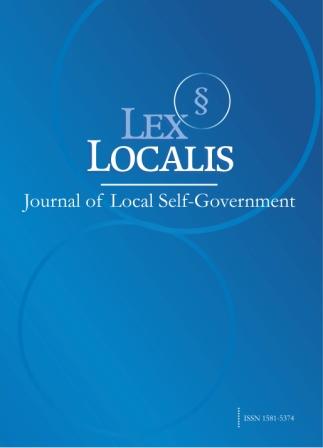Javne storitve: prisilna digitalizacija v pandemiji – nianse upravljanja
DOI:
https://doi.org/10.4335/21.1.93-116(2023)Ključne besede:
digitalni razkorak, digitalizacija, učinkovitost javnih storitev, indeks EGDI, cilji trajnostnega razvojaPovzetek
Cilj članka je kvantitativno in kvalitativno oceniti digitalno preobrazbo pri upravljanju javnih storitev ob upoštevanju pandemije. Razvit je bil analogni indeks razvoja e-uprave (EGDI) za ocenjevanje učinkovitosti digitalnih javnih storitev. Ugotovljene so bile kvalitativne in kvantitativne spremembe v digitalni transformaciji pri upravljanju javnih storitev ob upoštevanju pandemije. Ugotovljeno je bilo, da v inovativnih regijah Ruske federacije ni opaziti večjega obsega neobveznih ukrepov, namenjenih izboljšanju k strankam usmerjene narave javnih storitev in komunikacije. Ugotovljeno je bilo, da so glavne transformacije kvalitativne, saj je bil trend povečanja digitalizacije javnih storitev opažen že pred pandemijo, vendar so se med pandemijo povečale zahteve za širitev takšnih storitev, njihovo učinkovitost, osredotočenost na stranke in komunikacijo tako znotraj organizacije kot z uporabniki.
Literatura
András, B. & Gábor, B. (2021) Comparative analysis of evidence-based policies in the era of digitalization, Pro Publico Bono–Public Administration, 9(1), pp. 158-174.
Ansell, C., Sørensen, E. & Torfing, J. (2021) The COVID-19 pandemic as a game changer for public administration and leadership? The need for robust governance responses to turbulent problems, Public Management Review, 23(7), pp. 949-960, https://doi.org/10.1080/14719037.2020.1820272.
Cordella, A. & Tempini, N. (2015) E-government and organizational change: Reappraising the role of ICT and bureaucracy in public service delivery, Government Information Quarterly, 32(3), pp. 279-286, https://doi.org/10.1016/j.giq.2015.03.005/.
Corydon, B., Ganesan, V. & Lundqvist, M. (2016) Transforming government through digitization (New York: McKinsey), available at: https://www.mckinsey.com/industries/public-and-social-sector/our-insights/transforming-government-through-digitization#:~:text=By%20digitizing%2C%20governments%20can%20provide,over%20%241%20trillion%20annually%20worldwide (June 29, 2022).
Department of Economic and Social Affairs (2020) United Nations E-Government Surveys: 2020 Digital Government in the Decade of Action for Sustainable Development (New York: United Nations, Department of Economic and Social Affairs), available at: https://publicadministration.un.org/egovkb/Portals/egovkb/Documents/un/2020-Survey/2020%20UN%20E-Government%20Survey%20(Full%20Report).pdf (June 29, 2022).
Dostál, P. & Saey, P. (2000) Geography, public administration and governance, Belgeo, Revue belge de géographie, 2000(1-4), pp. 65-78, https://doi.org/10.4000/belgeo.13908.
Dunlop, C. A., Ongaro, E. & Baker, K. (2020) Researching COVID-19: A research agenda for public policy and administration scholars, Public Policy and Administration, 35(4), pp. 365-383, https://doi.org/10.1177/0952076720939631.
Dvinskikh, D. Y., Dmitrieva, N. E., Zhulin, A. B., Plaksin, S. M., Pliss, M. A., Sinyatullina, L. K., Styrin, E. M. & Faiziev, S. A. (2019) Digital transformation of public administration: myths and reality. Report to XX April International Scientific Conference on the problems of economic and social development (Moscow: Higher School of Economics Publishing House).
European Commission (2019) Digital Economy and Society Index 2018, available at: https://ec.europa.eu/digital-single-market/en/desi (June 29, 2022).
Hassankhani, M., Alidadi, M., Sharifi, A. & Azhdari, A. (2021) Smart city and crisis management: Lessons for the COVID-19 pandemic, International Journal of Environmental Research and Public Health, 18(15), https://doi.org/10.3390/ijerph18157736.
Ivanova, M., Degtereva, V. & Lukin, G. (2019) Evaluation of digital transformation of government: Russian and international systems of indicators, In: Shchepinin, V. (ed.) Proceedings of the 2019 International SPBPU Scientific Conference on Innovations in Digital Economy (New York: Association for Computing Machinery), pp. 1-8, https://doi.org/10.1145/3372177.3373330.
Kaesmayr, J., Schorn, M. & Steidle, A. (2021) Acceleration factor pandemic: A synthesis of e-government maturity models and public administration employees' perspective, In: Popkova, E. (ed.) Central and Eastern European eDem and eGov Days (Chișinău: Instrument Bibliometric National Institutul de Dezvoltare a Societatii Informationale), pp.19-32, https://doi.org/10.24989/ocg.v341.1.
Kamolov, S. G., Artemova, P. V. & Berezko, V. E. (2019) Shaping the systems of digital public governance of the digital economy in Russia and abroad, In: Popkova, E. (ed.) Ubiquitous computing and the Internet of Things: Prerequisites for the development of ICT (Cham: Springer), pp. 435-442, https://doi.org/10.1007/978-3-030-13397-9_51.
Kossasy, S. O., Jufri, Y., Monia, F. A. & Kosassy, S. M. (2021) Public services in the Covid-19 pandemic situation, Proceeding the First International Conference on Government Education Management and Tourism (Bandung, Indonesia), 1(1), pp. 495-499.
Mar, Š. & Buzeti, J. (2021) Working in public administration during nonwork time during the COVID-19 pandemic, Central European Public Administration Review, 19(1), pp. 223-242, https://doi.org/10.17573/cepar.2021.1.10.
Meijer, A. & Bolívar, M. P. R. (2016) Governing the smart city: a review of the literature on smart urban governance, International Review of Administrative Sciences, 82(2), pp. 392-408, http://dx.doi.org /10.1177/0020852314564308.
Melnikova, T. S. (2016) Foreign experience of development and popularization of electronic government (Saratov: Nauka).
Min, K., Yoon, M. & Furuya, K. (2019) A Comparison of a smart city’s trends in urban planning before and after 2016 through keyword network analysis, Sustainability, 11(11), http://dx.doi.org/ 10.3390/su11113155.
OECD (2016) Digital government strategies for transforming public services in the welfare areas, available at: https://www.oecd.org/gov/digital-government/Digital-Government-Strategies-Welfare-Service.pdf (June 29, 2022).
OECD (2018) Embracing Innovation in Government. Global Trends (Paris: OECD Publishing), available at: http://www.oecd.org/gov/innovative-government/embracing-innovation-in-government-2018.Pdf (June 29, 2022).
Roberts, A. (2020) The third and fatal shock: How pandemic killed the millennial paradigm, Public Administration Review, 80(4), pp. 603-609, https://doi.org/10.1111/puar.13223.
Safiullin, N. A. & Svirezhev, K. A. (2020) Chatbot for information support of users of the portal of state and municipal services of the Russian Federation, Moscow Economic Journal, 1, pp. 471-480.
Stojanovska-Stefanova, A., Aleksoski, O. & Magdinceva Sopova, M. (2020) E-government and digital public services: The Macedonian case of digitalization, Sociobrains, 7(74), pp. 35-52.
Ullah, M., Habibi, E. & Nezami, H. (2021) COVID-19 and public administration: Global economic management, International Journal of Academic Research in Economics and Management and Sciences, 10(1), pp. 34-45.
United Nation E-Government Knowledgebase (2018) E-Government Development Index, available at: https://publicadministration.un.org/egovkb/en-us/Data (June 29, 2022).
United Nations Division for Public Economic and Public Administration (2001) Benchmarking E-government: A global perspective: Assessing the UN member states, available at: https://publicadministration.un.org/egovkb/portals/egovkb/documents/un/english.pdf (June 29, 2022).
Vassilakopoulou, P., Haug, A., Salvesen, L. M. & O. Pappas, I. (2022) Developing human/AI interactions for chat-based customer services: lessons learned from the Norwegian government, European Journal of Information Systems, in press, https://doi.org/10.1080/0960085X.2022.2096490.
Zilincikova, M. & Stofkova, J. (2021) Impact of COVID 19 on the provision of services by public administration, SHS Web of Conferences (Les Ulis: EDP Sciences), 92, p. 01059, https://doi.org/10.1051/shsconf/20219201059.








